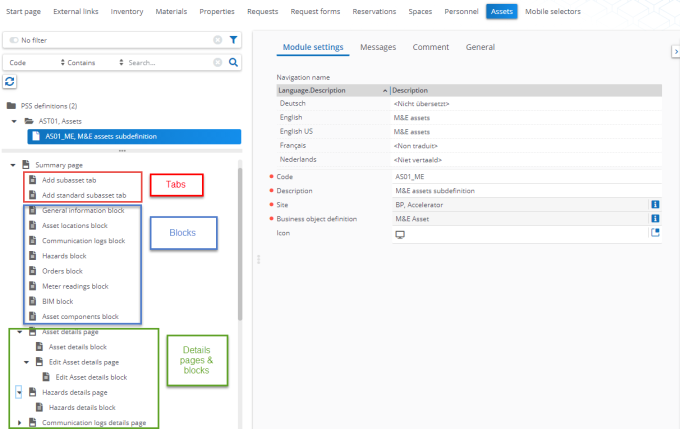Configuring Asset sub web definitions
In the Assets module, a sub web definition (system name: MobileAssetSubDefinition) consists of a Summary page, multiple blocks and details pages, which hold the more specific asset information.

You must configure a separate sub web definition for each asset type (user-defined asset) you want to show on the app. Each sub will include a configuration that is specific to the linked user-defined asset type.
For example, you can configure separate sub web definitions for M&E assets and for Building elements. See Configuring the Asset 'Summary' page & blocks for the procedure of adding a sub web definition.
For general information on user-defined business objects in Planon, see the Field definer user documentation. |
• The Summary page of the subdefinition consists of blocks, tabs where you can make settings and configure fields and actions. On the main blocks you can, for example, make settings to show or hide the selected block, configure a fixed filter, show the block as a micro block on the app, change the block's title or its position, and so on.
◦ Each of the main blocks on the summary page has corresponding details pages and details blocks for which you can make further settings. Example: the Hazards block corresponds with the Hazards details page and Hazard details block. If end users select a hazard on the Hazards block, they are directed to the Hazards details page.
◦ The Add subasset tab includes an action button that allows app users to add a new subasset to an existing asset from the Summary page. The Add standard subasset tab includes a similar action button that allows users to select a subasset from the asset library.
The Add standard subasset tab is only displayed as a separate action tab if the selected asset on the Summary page itself is also based on a standard asset. |
◦ General information block
◦ Asset locations block - allows app users to view the details of the location(s) assigned to the selected asset. The display of assets with multiple locations (non-unique assets) is also supported.
◦ Communication logs block - shows app users a summary of the communication logs that are related to the asset (documents, images).
◦ Hazards block - shows app users a summary of the hazards that are related to the asset.
◦ Orders block - shows detailed information of the orders that are related to the selected property.
◦ Meters block - shows app users a summary of the meters and meter readings that are related to the asset.
◦ BIM block - displays the available BIM models that can be viewed for the selected asset.
◦ Observations block - shows app users information about any observation(s) made for the asset / building element
◦ Asset components block - shows app users a summary of the components that are part of the asset. This block is not visible in web definitions that are based on building elements.
◦ Details pages; one for each of these blocks. These details pages zoom in on the details of asset locations, communication logs, meter readings, orders etc.
• Add asset page with Add asset block and Upload block - allows app users to add a new asset or upload asset documents / images (communication logs).
• Standard asset library page with a Search block, List block
◦ Add standard asset page with a Add standard asset block and an Upload block - allows app users to add assets based on standard assets, or to upload documents / images (communication logs) for these assets.
On the Add asset block and Add standard asset block, you can configure which fields you want to display on the end user's Add forms. Most notable are the Code and Asset tag fields with a Show QR code scanner setting. If you select Yes, the QR code scanner is displayed in these fields, to allow end users to scan a QR code instead of entering it manually. This way they can make sure that the scanned code matches the code in Planon. |